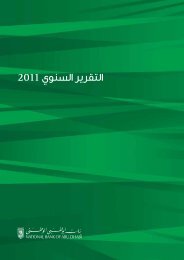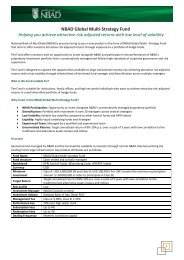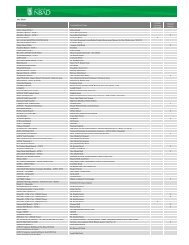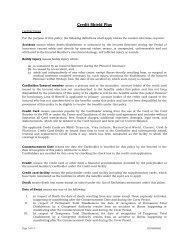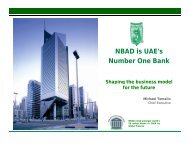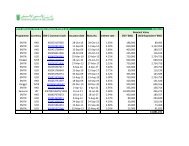English Version - National Bank of Abu Dhabi
English Version - National Bank of Abu Dhabi
English Version - National Bank of Abu Dhabi
Create successful ePaper yourself
Turn your PDF publications into a flip-book with our unique Google optimized e-Paper software.
Notes to the consolidated financial statements<br />
Notes to the consolidated financial statements<br />
3 Significant accounting policies (continued) 3 Significant accounting policies (continued)<br />
their fair value, are accounted for as compound financial<br />
instruments. The equity component <strong>of</strong> the subordinated<br />
convertible notes is calculated as the excess <strong>of</strong> issue<br />
proceeds over the present value <strong>of</strong> the future interest<br />
and principal payments, discounted at the market rate <strong>of</strong><br />
interest applicable to similar liabilities that do not have a<br />
conversion option.<br />
(o) Share option scheme<br />
The grant date fair value <strong>of</strong> options granted to staff is<br />
recognised as staff cost, with a corresponding increase<br />
in equity, over the period in which the staff become<br />
unconditionally entitled to the options. The amount<br />
recognised as an expense is adjusted to reflect the<br />
number <strong>of</strong> share options for which the related service<br />
conditions are expected to be met, such that the amount<br />
ultimately recognised as an expense is based on the<br />
number <strong>of</strong> share options that do meet the related service<br />
and non-market performance conditions at the vesting<br />
date.<br />
The fair value <strong>of</strong> the amount payable to staff in respect<br />
<strong>of</strong> the share appreciation rights that are settled in cash is<br />
recognised as an expense with a corresponding increase<br />
in liabilities, over the period in which the employees<br />
become unconditionally entitled to payment. The<br />
liability is remeasured at each reporting date and at<br />
settlement date. Any changes in the fair value <strong>of</strong> the<br />
liability are recognised as staff costs in consolidated<br />
income statement.<br />
(p) Interest<br />
Interest income and expense are recognised in the<br />
consolidated income statement using the effective<br />
interest method. The effective interest rate is the rate<br />
that exactly discounts the estimated future cash flows<br />
through the expected life <strong>of</strong> the financial asset or liability<br />
to the carrying amount <strong>of</strong> the financial asset or liability.<br />
The calculation <strong>of</strong> the effective interest rate includes<br />
all fees paid or received that are an integral part <strong>of</strong><br />
the effective interest rate. Transaction costs include<br />
incremental costs that are directly attributable to the<br />
acquisition or issue <strong>of</strong> a financial asset or liability.<br />
Interest income and expense presented in the<br />
consolidated income statement include:<br />
• interest on financial assets and liabilities at amortised<br />
cost on an effective interest basis.<br />
• interest on available-for-sale investment securities on an<br />
effective interest basis.<br />
• interest on held for trading securities.<br />
(q) Fee and commission<br />
The Group earns fee and commission income from a<br />
diverse range <strong>of</strong> services provided to its customers.<br />
Recognition <strong>of</strong> revenue for fee and commission income<br />
depends on the purposes for which the fees are assessed<br />
and the basis <strong>of</strong> accounting for the associated financial<br />
instrument. Fee and commission income is accounted<br />
for as follows:<br />
• income which forms an integral part <strong>of</strong> the effective<br />
interest rate <strong>of</strong> a financial instrument is recognised as<br />
an adjustment to the effective interest rate (for example,<br />
loan commitment fees) and recorded in “Interest<br />
income”;<br />
• income earned from the provision <strong>of</strong> services is<br />
recognised as revenue as the services are provided (for<br />
example, loan processing fees,<br />
investment management fees and loan syndication<br />
fees); and<br />
• income earned on the execution <strong>of</strong> a significant act is<br />
recognised as revenue when the act is completed (for<br />
example, commission on the allotment <strong>of</strong> shares to a<br />
client, placement fees for arranging a loan between the<br />
borrower and an investor).<br />
Fee and commission expense relates mainly to<br />
transaction and service fees which are expensed as the<br />
services are received.<br />
(r) Net investment income<br />
Net investment income comprise gains less losses<br />
relating to realised and unrealised gains and losses on<br />
investments at fair value through pr<strong>of</strong>it or loss, realised<br />
gains and losses on non-trading investments and<br />
dividend income. Dividend income is recognised when<br />
the right to receive payment is established.<br />
(s) Foreign currency<br />
(i)<br />
Foreign currency transactions<br />
Transactions in foreign currencies are translated into the<br />
respective functional currencies <strong>of</strong> the Group entities at<br />
spot exchange rates at the dates <strong>of</strong> the transactions.<br />
Monetary assets and liabilities denominated in foreign<br />
currencies at the reporting date are retranslated to the<br />
functional currency at the spot exchange rates at the<br />
reporting date. The foreign currency gain or loss on<br />
monetary items is the difference between amortised cost<br />
in the functional currency at the beginning <strong>of</strong> the period,<br />
adjusted for effective interest and payments during the<br />
period, and the amortised cost in foreign currency<br />
translated at the exchange rate at the end <strong>of</strong> the period.<br />
Foreign currency differences arising on retranslation are<br />
recognised in pr<strong>of</strong>it or loss.<br />
(ii) Foreign operations<br />
The activities <strong>of</strong> subsidiaries and branches based<br />
outside the UAE are not deemed an integral part <strong>of</strong><br />
the head <strong>of</strong>fice operations, as they are financially and<br />
operationally independent <strong>of</strong> the head <strong>of</strong>fice. The assets<br />
and liabilities <strong>of</strong> the subsidiaries and overseas branches<br />
are translated into UAE Dirhams at rates <strong>of</strong> exchange<br />
at the reporting date. Income and expense items are<br />
translated at average rates, as appropriate, at the dates <strong>of</strong><br />
transactions. Exchange differences (including those on<br />
transactions which hedge such investments) arising from<br />
retranslating the opening net assets, are taken directly to<br />
foreign currency translation adjustment account in other<br />
comprehensive income.<br />
(t) Overseas income tax<br />
Income tax expense is provided for in accordance with<br />
fiscal regulations <strong>of</strong> the respective countries in which the<br />
Group operates and is recognised in the consolidated<br />
income statement. Income tax expense is the expected<br />
tax payable on the taxable income for the year, using tax<br />
rates enacted or substantively enacted at the reporting<br />
date and any adjustment to tax payable in respect <strong>of</strong><br />
previous years.<br />
Deferred tax is provided using the liability method on<br />
all temporary differences between the carrying amounts<br />
<strong>of</strong> assets and liabilities for financial reporting purposes<br />
and the amounts used for taxation purposes. Deferred<br />
tax is not recognised for the following temporary<br />
differences: the initial recognition <strong>of</strong> goodwill, the initial<br />
recognition <strong>of</strong> assets or liabilities in a transaction that<br />
is not a business combination and that affects neither<br />
accounting nor taxable pr<strong>of</strong>it or loss, and differences<br />
relating to investments in subsidiaries to the extent<br />
that they probably will not reverse in the foreseeable<br />
future. Deferred tax is measured at the tax rates that<br />
are expected to apply to the period when the asset is<br />
realised or the liability is settled, based on laws that have<br />
been enacted at the reporting date.<br />
A deferred tax asset is recognised only to the extent<br />
that it is probable that future taxable pr<strong>of</strong>its will be<br />
available against which the asset can be utilised. The<br />
carrying amount <strong>of</strong> deferred tax assets is reviewed at<br />
each reporting date and reduced to the extent that it is<br />
no longer probable that sufficient taxable pr<strong>of</strong>it will be<br />
available to allow all or part <strong>of</strong> the deferred tax asset to<br />
be utilised.<br />
(u) Derivative financial instruments and hedging<br />
Derivatives are initially recognised, and subsequently<br />
measured at fair value with transaction costs taken<br />
directly to the consolidated income statement. The fair<br />
value <strong>of</strong> a derivative is the equivalent <strong>of</strong> the unrealised<br />
gain or loss from marking to market the derivative or<br />
using valuation techniques, mainly discounted cash<br />
flow models.<br />
Derivatives with positive fair values (unrealised gains)<br />
are included in other assets and derivatives with<br />
negative fair values (unrealised losses) are included in<br />
other liabilities.<br />
The method <strong>of</strong> recognising the resulting fair value gains<br />
or losses depends on whether the derivative is held for<br />
trading, or is designated as a hedging instrument and,<br />
if so, the nature <strong>of</strong> the risk being hedged. All gains and<br />
losses from changes in fair value <strong>of</strong> derivatives held<br />
for trading are recognised in the consolidated income<br />
statement. When derivatives are designated as hedges,<br />
the Group classifies them as either: (i) fair value hedges<br />
which hedge the exposure to changes in the fair value<br />
<strong>of</strong> a recognised asset or liability; (ii) cash flow hedges<br />
which hedge exposure to variability in cash flows that<br />
is either attributable to a particular risk associated with<br />
a recognised asset or liability. Hedge accounting is<br />
applied to derivatives designated as hedging instruments<br />
in a fair value or cash flow, provided certain criteria are<br />
met.<br />
Hedge accounting<br />
It is the Group’s policy to document, at the inception <strong>of</strong><br />
a hedge, the relationship between hedging instruments<br />
and hedged items, as well as risk management objective<br />
and strategy. The policy also requires documentation <strong>of</strong><br />
the assessment, at inception and on an ongoing basis, <strong>of</strong><br />
the effectiveness <strong>of</strong> the hedge.<br />
Hedge accounting is discontinued when the hedging<br />
instrument expires or is sold, terminated or exercised, or<br />
no longer qualifies for hedge accounting.<br />
53




